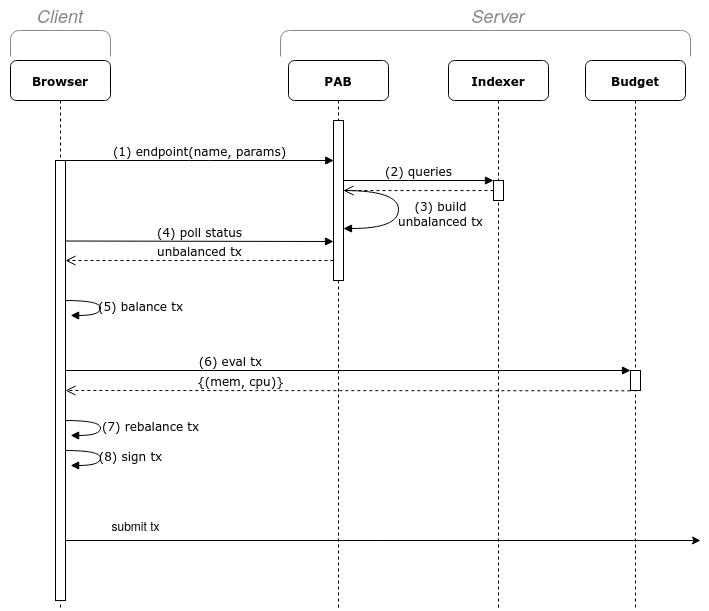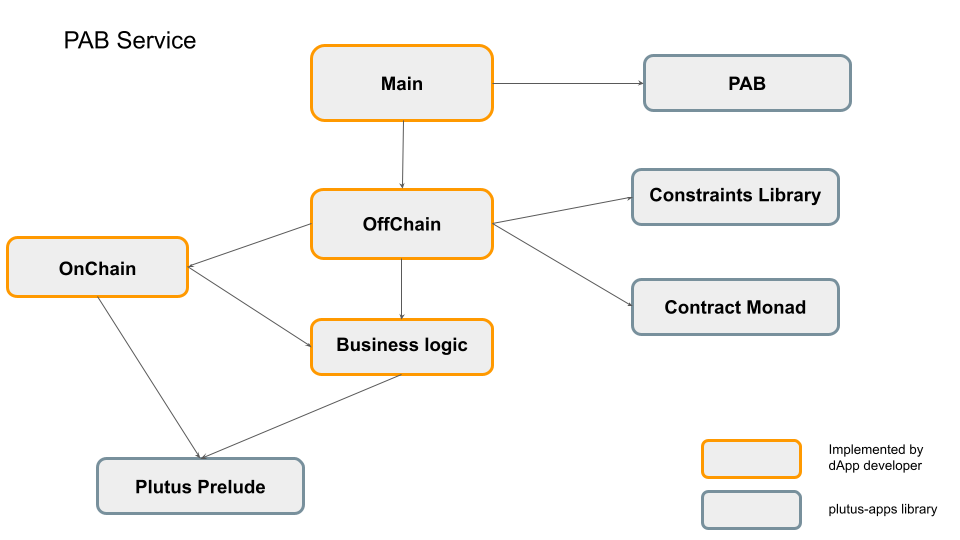2. Cardano dApp Architecture
In order to introduce the dApp architecture we propose, let’s quickly remind what a smart contract, or better called decentralized Application (dApp), is on Cardano. Unlike EVM blockchains, where a smart contract is a program that executes instructions modifying a state inside the blockchain, the unique piece of code running on-chain in Cardano is a validator. This is just a boolean function that decides if a submitted transaction must be accepted or not. The state of a dApp is stored in one or more utxos, and the way of updating it, is by submitting transactions that spend those utxos and produce others. Here comes the off-chain code, which is in charge of building, balancing, signing and submitting transactions.
For implementing the off-chain side of a dApp, we propose a Client-Server architecture. The unique component on the Client side is the Browser, which runs the dApp frontend code, balances, signs and submits transactions. In this approach we consider CIP30 light wallets, that run on the Browser and interact with the blockchain for getting utxos information and submitting transactions.
On the Server side, we have three services: the Plutus Application Backend (PAB), an Indexer service, and a Budget service. The PAB is in charge of running the dApp off-chain code for building an unbalanced transaction. The Indexer service is used by the PAB for querying the blockchain. Finally, the Budget service provides the evaluation of Plutus scripts, obtaining memory and CPU execution units that a validator consumes, which is needed for completing transactions’ balance.
Let’s briefly clarify what we mean with unbalanced transaction:
The inputs only include those utxos that are strictly necessary for the logic of the dApp (usually only script utxos or no inputs at all). Wallet inputs covering the payments that the signer must do are not included (with the only exception being wallet utxos that want to be consumed for NFT minting).
The fee, and the expected memory and CPU units for all the redeemers are not set (set to 0 actually).
No collateral is specified.
No signature is included.
Some other low-level transaction information is missing (e.g. the script data hash).
The following diagram shows the complete flow for performing a dApp operation:

The Browser sends an HTTP request to the corresponding operation endpoint provided by the PAB (1), which then performs some queries to the Indexer (2) and gets the information needed for building the unbalanced transaction (3). For getting it, it’s necessary to poll the PAB status. Once the unbalanced transaction is received, the Browser balances it (5) and obtains the memory and CPU units of the included scripts by calling the Budget service (6). With that information, the definitive balance can be computed (7) and the transaction is ready for signing (8) and submitting (9).
2.1. Server Side
Two of the three components included on the Server side are common services for any dApp: the Indexer and the Budget. Let’s focus on the remaining one, which is specific to each dApp, in charge of exposing endpoints for getting the application state and building unbalanced transactions for each operation.
The plutus-apps library provides an easy way to implement a web server for exposing endpoints connected to each dApp operation. This web server is known as Plutus Application Backend. In its original version, the PAB and all the related components were conceived for being in charge of the entire flow of building, balancing, signing, submitting and checking the status of transactions. In our approach, we propose to use the plutus-apps tools only for building unbalanced transactions. It avoids a lot of problems related to blockchain syncing, transaction submissions, rollbacks and others, but still allows to use Haskell code for running the necessary dApp business logic, with the huge benefit of sharing the same code between the on-chain validator and the off-chain code. Concretely, we use Contract Monad just for connecting with the Indexer service (currently using Blockfrost, but it can be replaced by any other) and the Constraints Library, which provides a declarative interface for building transactions.
The following diagram shows a simplified version of PAB service’s design of a dApp:

In general, the computation needed for updating the state of a dApp must be done in both sides off-chain and on-chain. We call Business logic to the piece of code in charge of that. It’s implemented on Haskell using Plutus Prelude library. The OnChain module contains validator code, which depends on the Business logic and Plutus Prelude. This Haskell code is then compiled into Plutus Core. The OffChain module contains the core code for building transactions. It depends on plutus-apps libraries Contract Monad (for querying the blockchain) and Constraints Library (for building the transaction), the OnChain module for including the validators in the transactions, and the Business logic for the core computations. Finally, the web service is implemented on the Main module, using the plutus-apps tool PAB. It basically interprets the OffChain code, exposing the dApps endpoints and running the Contract monad for each operation.
2.2. Client Side
In our approach, the core part of a dApp is implemented in the Server, but important parts are done in the Client side. The end user interacts with the dApp web frontend for triggering the operations. The critical work of building the unbalanced transaction is done on the server and then we balance, sign and submit on the browser. For implementing the web frontend we present the PAB Client library which provides an easy interface for interacting with PAB, Budget service and light wallets.

The dApp developer implements the dApp frontend using a set of libraries. Contract endpoints provides an API for abstracting the connection with PAB, which uses a lower level module called PAB API. Their main purpose consists on obtaining the dApp state and unbalanced transactions to be submitted. CIP30Wallet Wrapper provides an API for easily connecting with CIP30 wallets and obtaining utxos information, signing and submitting transactions. Balancing algorithm is implemented on Balancer module. Both CIP30Wallet Wrapper and Balancer depends on the Serialization Library. Finally, Budget API provides an API for connecting to the Budget service.